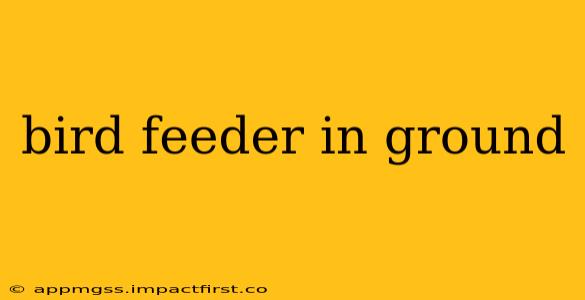Are you looking to attract a vibrant array of birds to your backyard? A ground bird feeder can be a fantastic addition to your bird-watching setup, offering a unique way to observe these beautiful creatures up close. But choosing and maintaining the right ground feeder requires some careful consideration. This guide explores everything you need to know about ground bird feeders, answering common questions and providing expert advice to help you create a thriving bird haven.
What are the benefits of a ground bird feeder?
Ground feeders offer several advantages over traditional hanging feeders. They are particularly appealing to species that forage on the ground, such as juncos, sparrows, doves, and towhees. These birds might be intimidated by hanging feeders or lack the agility to access them. Ground feeders also provide a more accessible feeding area for birds with mobility issues or those who prefer to feed in safety from predators. Furthermore, they can be visually appealing and add a unique element to your garden's landscaping.
What are the disadvantages of a ground feeders?
While ground feeders offer many advantages, they also come with some drawbacks. The most significant disadvantage is the increased risk of seed spillage and waste. This can attract unwanted pests like rodents or insects. Furthermore, ground feeders are more susceptible to contamination from rain, snow, or droppings. Keeping them clean and replenished is crucial to prevent the spread of disease among your feathered friends. Finally, ground feeders are more vulnerable to predation, particularly from larger birds, cats, and other animals.
What types of birds are attracted to ground feeders?
Many ground-foraging birds are drawn to ground feeders. Some common visitors include:
- Juncos: These small, dark-colored birds are frequent visitors to ground feeders.
- Sparrows: Various sparrow species happily feed from the ground.
- Doves: Doves, with their gentle demeanor, are a common sight at ground feeders.
- Towhees: These larger birds are known for their distinctive calls and ground-feeding habits.
- Chickadees: While they also use hanging feeders, chickadees will readily scavenge spilled seed from the ground.
- Robins: During colder months or when other food sources are scarce, robins will often visit ground feeders.
What kind of birdseed is best for a ground feeder?
Choosing the right birdseed is vital for attracting a diverse range of birds. A good blend typically includes:
- Sunflower seeds: A favorite amongst many bird species, offering high-energy content.
- Millet: A less expensive option that attracts smaller birds like sparrows and juncos.
- Cracked corn: Popular with larger birds like doves and ground-feeding pigeons.
- White-striped sunflower seeds: These larger seeds attract bigger birds and are less likely to be scattered by the wind.
Avoid using mixes containing fillers like wheat or milo, as these are less appealing to most birds and contribute to waste.
How do I keep my ground bird feeder clean?
Regular cleaning is crucial to prevent disease and attract more birds. Aim to clean your feeder at least once a week, more frequently during warmer, wetter months. Remove any spilled seed and debris, and thoroughly wash the feeder with soap and water, rinsing well before refilling. Allow the feeder to dry completely before placing it back in its location.
How do I protect my ground bird feeder from pests and predators?
Protecting your ground feeder from unwanted visitors is essential. Consider these strategies:
- Placement: Place the feeder in an open area, away from shrubs and tall grasses that can provide cover for predators.
- Enclosure: Use a feeder with a protective cage or baffle to keep out larger birds or squirrels.
- Regular cleaning: Keeping the feeder clean minimizes the attraction of pests.
- Elevated platform: Placing the feeder on a raised platform can make it harder for cats and other ground predators to access.
- Strategic placement of feeders: Having multiple feeders, some hanging and some on the ground, can reduce the concentration of birds in one area, minimizing predator attraction.
By following these tips and choosing the right ground bird feeder, you can create a thriving and enjoyable bird-watching experience right in your backyard. Remember to observe your feathered friends, adjust your approach as needed, and enjoy the beauty and wonder they bring to your space.
